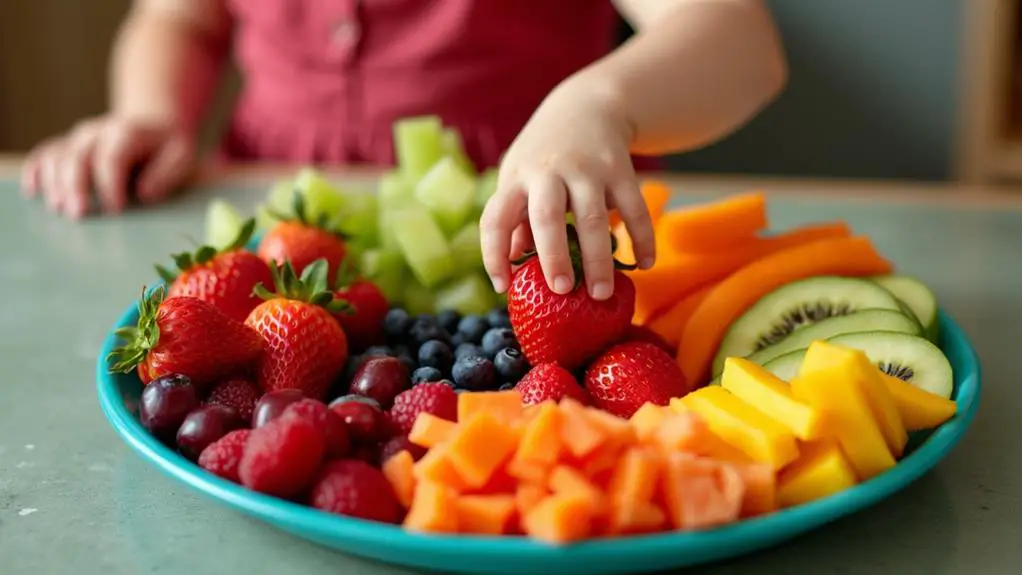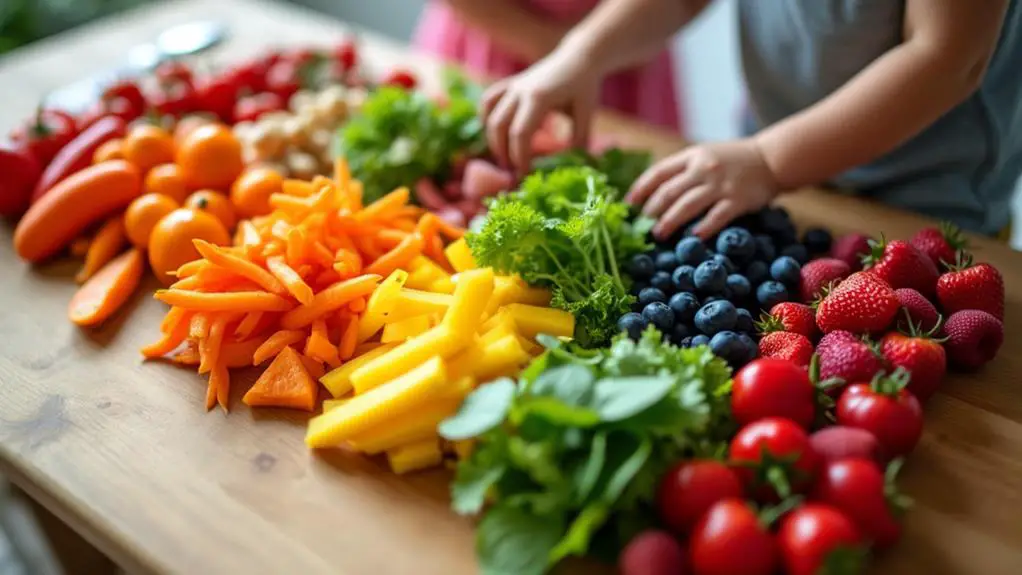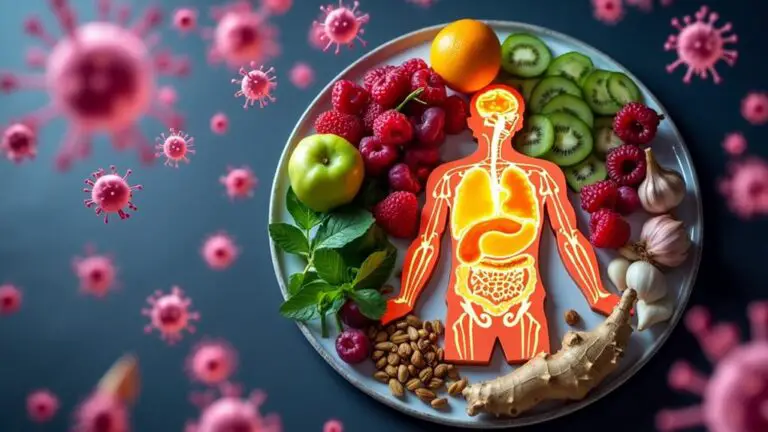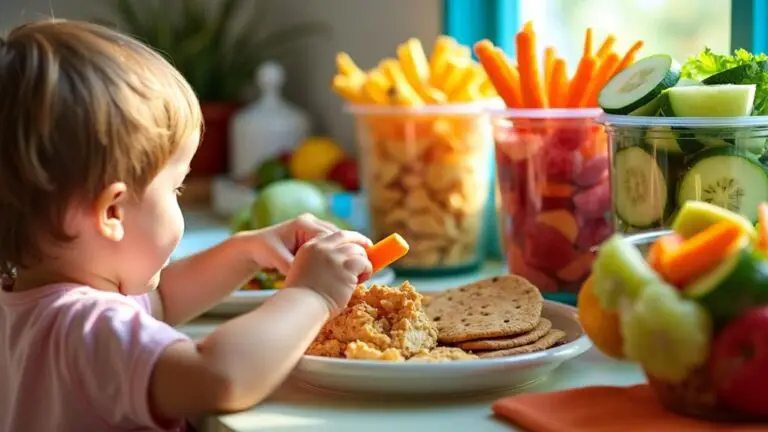Teaching Kids About the Benefits of Different Colored Foods
Teaching kids about the benefits of different colored foods can make healthy eating fun and engaging. You'll want to emphasize how each color represents unique nutrients that support various aspects of health. Use creative activities like creating "rainbow plates" or taste-testing colorful fruits and vegetables to spark interest. Involve children in grocery shopping and meal preparation to increase their enthusiasm. Make presentations visually appealing with colorful infographics or fun food arrangements. By explaining the importance of eating a variety of colors, you'll help kids develop lifelong healthy eating habits. Discover more ways to make nutrition education exciting and effective for young minds.
Key Takeaways
- Explain how different food colors represent various nutrients and health benefits using kid-friendly language.
- Create engaging activities like "rainbow plate" challenges or colorful food taste tests to make learning interactive.
- Use visual aids, infographics, and creative presentations to make nutrition education memorable and appealing.
- Involve children in meal planning, grocery shopping, and food preparation to encourage interest in diverse foods.
- Introduce new foods gradually and celebrate trying them to foster positive associations with varied eating habits.
The Rainbow on Your Plate
When you look at your plate, do you see a vibrant array of colors? If not, you're missing out on the incredible benefits of eating fruits and vegetables across the color spectrum.
"Eating the rainbow" isn't just a catchy phrase; it's a smart approach to nutrition that guarantees you're getting a variety of colorful foods packed with essential vitamins and minerals.
Each hue offers unique health advantages. Red foods like tomatoes support heart health, while orange and yellow produce boost immunity and eye health.
Green veggies enhance immune function and provide crucial nutrients for growth. Blue and purple fruits improve cognitive function and may reduce the risk of chronic diseases.
Unlocking Nature's Color Code
You'll discover a wealth of nutritional benefits by understanding nature's color code in fruits and vegetables.
Each hue represents a unique set of phytonutrients, offering specific health advantages that contribute to your overall well-being.
Nature's Nutritional Color Wheel
Nature's nutritional color wheel offers a vibrant guide to revealing the health benefits of fruits and vegetables. By incorporating different colors into your diet, you're guaranteeing a wide range of vitamins and nutrients that help keep your body functioning at its best.
Red foods like tomatoes and strawberries are packed with lycopene, which supports heart health. Orange and yellow produce, such as carrots and oranges, provide beta-carotene for improved vision. Green vegetables like spinach and broccoli are rich in vitamins A, C, and K, boosting your immune system.
To make the most of nature's color wheel:
- Aim to eat fruits and vegetables from each color group daily
- Create colorful meals to guarantee a variety of nutrients
- Encourage kids to "eat the rainbow" for a fun, healthy approach
Blue and purple foods, including blueberries and eggplants, offer anthocyanins that enhance memory and cognitive function.
Decoding Phytonutrient Benefits
Beneath the vibrant hues of fruits and vegetables lies a hidden code of health benefits. These powerful plant compounds, called phytonutrients, work synergistically with vitamins and minerals to boost your immune system and protect against chronic diseases. By decoding nature's color palette, you'll reveal a world of nutritional advantages for your children.
| Color | Phytonutrients | Benefits | Examples |
|---|---|---|---|
| Red | Lycopene | Reduces cancer risks | Tomatoes, Berries |
| Orange | Beta-carotene | Supports eye health | Carrots, Oranges |
| Green | Lutein, Zeaxanthin | Enhances cognitive function | Spinach, Broccoli |
| Blue | Anthocyanins | Improves memory | Blueberries, Plums |
Encourage your kids to explore a rainbow of fruits and vegetables. They'll not only enjoy the diverse flavors but also reap the benefits of vitamins A and C, along with thousands of unique phytonutrients that support their growth and development.
Exploring Vibrant Nutritional Benefits

You'll find that nature's vibrant palette offers more than just visual appeal—it's a guide to ideal nutrition.
By incorporating a rainbow of fruits and vegetables into your diet, you're tapping into a wealth of health-boosting phytonutrients.
Let's explore how different colors translate to specific nutritional benefits and discover engaging ways to make your plate as colorful as possible.
Color-Coded Health Benefits
A vibrant rainbow of fruits and vegetables offers more than just visual appeal on your plate. Each color group provides unique health benefits that can boost your overall well-being.
Red fruits like tomatoes and strawberries are packed with lycopene, supporting heart health and potentially reducing cancer risks. Orange and yellow fruits, such as carrots and oranges, promote good eyesight and strengthen your immune system with beta-carotene and vitamin C.
Green foods like spinach and broccoli are nutritional powerhouses, offering vitamins A, C, and K, while aiding digestion. Blue and purple produce contain anthocyanins that may improve memory and cognitive function.
To make the most of these color-coded benefits:
- Aim for a diverse range of colors on your plate
- Incorporate at least one colorful fruit or vegetable in each meal
- Experiment with new recipes featuring different colored foods
Engaging Rainbow Activities
Engaging children in colorful food activities can turn nutritional education into an exciting adventure. You can encourage kids to explore a wide variety of fruits and vegetables through fun challenges like creating a "rainbow plate" with five different colors at each meal. This approach helps them understand how eating fruits and veggies in various hues can keep us healthy.
| Activity | Benefit |
|---|---|
| Edible insect crafting | Enhances interest in healthy eating |
| Rainbow plate challenge | Encourages exploration of diverse produce |
| Taste tests | Helps identify flavors and health benefits |
| Colorful infographics | Makes nutrition education memorable |
| Growing a garden | Fosters hands-on learning and excitement |
Phytonutrients Made Simple
While rainbow activities make nutrition fun for kids, understanding the science behind colorful foods can be equally fascinating for adults. Phytonutrients, the naturally occurring compounds in fruits and vegetables, offer a wide array of health benefits. With up to 4,000 different phytonutrients identified, these powerful substances contribute to overall well-being and disease prevention.
To simplify the concept of phytonutrients, remember these key points:
- Colors indicate specific health benefits
- Red foods support heart health
- Blue and purple foods enhance memory
You'll find that each color group provides unique advantages. For instance, red tomatoes and strawberries contain lycopene and quercetin, which may reduce cancer risk.
Blue and purple foods like blueberries and eggplants offer flavonoids and anthocyanins, potentially lowering the risk of chronic diseases. By incorporating a variety of colorful fruits and vegetables into your diet, you're ensuring a diverse intake of these beneficial compounds.
Fun Activities for Color Learning
Learning about the health benefits of colorful fruits and vegetables doesn't have to be boring. You can encourage kids to eat a rainbow of foods and stay healthy through engaging activities.
Create edible insects using vibrant produce, allowing children to explore their creativity while learning about nutrition. Organize a "rainbow tasting party" where kids sample various colorful fruits and veggies, understanding how different hues relate to health benefits.
Set up a color scavenger hunt in the produce aisle, making grocery shopping an educational adventure. Develop a food art project where children arrange fruits and vegetables into eye-catching designs.
These hands-on experiences make nutrition visually appealing and enjoyable. By incorporating fun facts about phytochemicals, you can explain how these compounds protect against diseases, further emphasizing the importance of eating a colorful diet.
Making Colorful Foods Appealing

Once you've sparked children's interest in colorful foods, it's time to turn that curiosity into action. Making colorful foods appealing involves engaging children in the process and presenting meals in exciting ways.
Create "Rainbow Days" to encourage variety and adventurous eating habits. Let kids choose and prepare ingredients, fostering excitement and ownership over their meals.
Here are three effective strategies to make colorful foods more enticing:
- Arrange fruits and vegetables in visually appealing patterns or shapes
- Incorporate tasty dips like hummus or yogurt to enhance raw vegetable flavors
- Use creative names for foods, such as "dinosaur trees" for broccoli
Health Impact of Diverse Diets
Through a diverse diet rich in colorful fruits and vegetables, children can reap numerous health benefits. By eating a rainbow of veggies and fruits, your child will consume a wide range of essential nutrients that are vital for their growth and cognitive development.
These colorful foods are full of vitamins, minerals, and phytochemicals that boost immune function, improve digestion, and reduce the risk of chronic diseases.
Studies show that children who consume a variety of colored foods have higher nutrient intake and better health outcomes. They're more likely to have increased energy levels, improved mood, and enhanced academic performance.
To guarantee your child gets these benefits, they need to eat a diverse range of fruits and vegetables daily. This variety not only provides essential nutrients but also protects against environmental stressors and supports overall health.
Conclusion
You've now got the tools to make healthy eating a colorful adventure for your kids. Remember, it's not just about nutrition—it's about cultivating lifelong habits. Take Sarah's family, for instance. After implementing a "rainbow challenge" at mealtimes, her picky eater now enthusiastically tries new foods. He's even started asking for "purple power" at the grocery store! By embracing nature's palette, you're setting your children up for a vibrant, healthy future.







